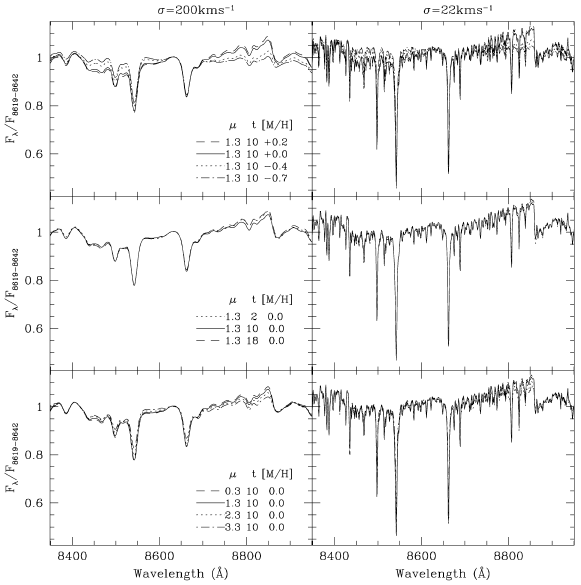CaT models
Tarfiles with all the predictions for this set of models can be retrieved from here:
| CaT models (v11.0) |
We present here stellar populations spectra in the  near-IR region covering the range 8350-8950Å at a resolution 1.5Å (FWHM). These models can be used to derive reliable predictions for the Calcium Triplet strength, i.e. the main feature in this spectral range. These SSP predictions cover a wide metallicity range -1.7<[Fe/H]<+0.2 for old- and intermediate-aged stellar populations. The main ingredient for these predictions, is the extensive empirical stellar spectral library presented in Cenarro et al. (2001), from which a subsample composed of more than 600 stars has been carefully selected. The sample shows a good coverage of the stellar atmospheric parameters (Teff, log(g) and [M/H]) for stellar population synthesis modeling.
near-IR region covering the range 8350-8950Å at a resolution 1.5Å (FWHM). These models can be used to derive reliable predictions for the Calcium Triplet strength, i.e. the main feature in this spectral range. These SSP predictions cover a wide metallicity range -1.7<[Fe/H]<+0.2 for old- and intermediate-aged stellar populations. The main ingredient for these predictions, is the extensive empirical stellar spectral library presented in Cenarro et al. (2001), from which a subsample composed of more than 600 stars has been carefully selected. The sample shows a good coverage of the stellar atmospheric parameters (Teff, log(g) and [M/H]) for stellar population synthesis modeling.
We find with these models the following behaviour of the CaII triplet for old-aged SSPs: i) the strength of the CaT* index does not change much with time for all metallicities for ages larger than ~3 Gyr, ii) this index shows a strong dependence with metallicity for values below [M/H]~-0.5 and iii) for larger metallicities this feature is far more sensitive to changes in the slope of power-like IMF shapes.
The SSP spectra have been calibrated with measurements for globular clusters, which are well reproduced, probing the validity of using the integrated CaT* feature for determining the metallicities of these systems. For massive early-type galaxies we find that the CaT measurements cannot be fitted unless a very dwarf-dominated IMF is imposed, or if the Ca abundance is even lower than the Fe abundance. More details can be found in Cenarro et al. (2003) and Falcón-Barroso et al. (2003).